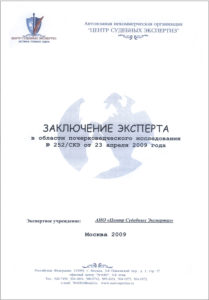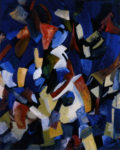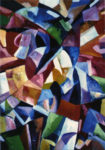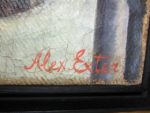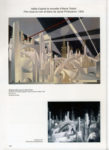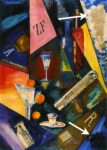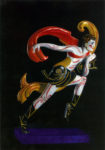On 19 March 2009, the French police confiscated a series of paintings attributed to Alexandra Exter that were being exhibited in the municipal rooms of the Château de Tours. The judicial system was acting on a complaint filed by the Alexandra Exter Association (See communiqué of the Tours state prosecutor complaint challenging the authenticity of most of the works presented at an exhibition that was inaugurated with much fanfare on 29 January 2009.
For several years prior to the exhibition, the art market was being flooded with works attributed indiscriminately and incorrectly to Alexandra Exter. The situation had become so alarming that the Alexandra Exter Association felt compelled , on 2 July 2006 to put out a « communiqué » drawing attention to the appearance of an increasing number of works of dubious attribution.
On two floors of the 2009 Tours exhibition titled “Alexandra Exter et ses amis” (Alexandra Exter and friends”) were displayed 180 oil paintings and large gouaches on paper presented as being from the artist’s “Cubo-Futurist” (1910-1914) and “constructivist” (1917-1923) period, all duly signed and attributed to Alexandra Exter.
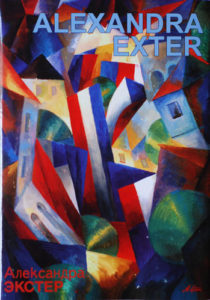
On the third floor were 80 other works by “friends” of the artist, including Kandinsky (sic !), Jawlenski, Malewicz, Larionov, Gontcharova, Rodchenko, and Lissitzky among others. Presumed to be fakes, these pieces were also sequestered. Works bearing the same signature “Alex. Exter”, which appeared to belong stylistically to the series of counterfeits on display at the Tours exhibition, were confiscated the same day at the Paris home of Jean Chauvelin, the man behind the exhibition. Art dealer and expert specialist for the Hôtel Drouot auction house in Paris, this former gallery owner authenticated all of the works at the exhibition and authored a text in the accompanying publication.
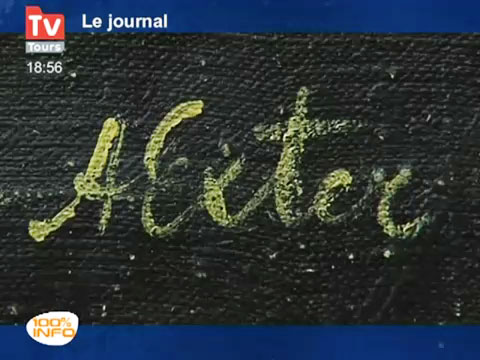
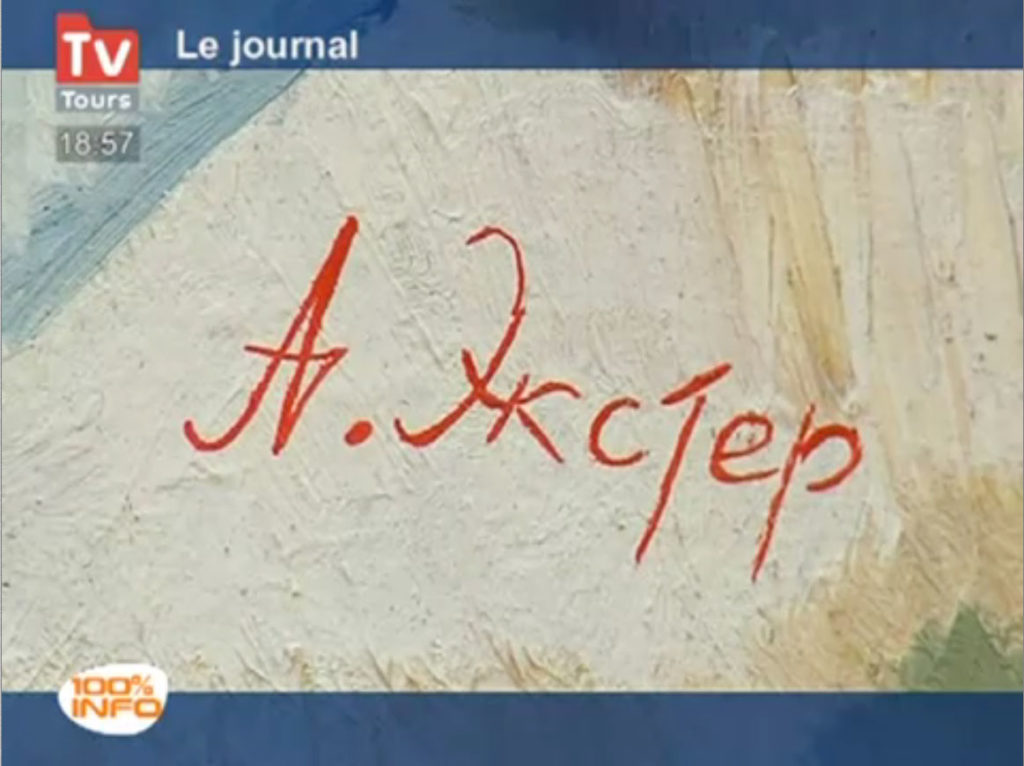
The Alexandra Exter publication, presented as an exhibition catalogue, could hardly be said to meet established museum standards and criteria for public exhibitions catalogues. Aside from the text by Jean Chauvelin, the publication included an article by Nadia Filatoff, a regular associate of Chauvelin, and a much shorter text by Maria Valyaeva, who worked until recently as an assistant at the Tretyakov Gallery in Moscow.
Aside from the stylistic discrepancies (execution of forms, errors in dating, serious compositional mistakes, etc.), most of the works on display at the Tours exhibition bore forged signatures. This was confirmed by a handwriting analysis that the Alexandra Exter Association commissioned from Ms. Mangaud and Ms. Haller-Fegly, two experts accredited by the Paris Court of Appeals.
Their conclusions were subsequently substantiated by two analyses conducted in Moscow in April and May 2009 by sworn experts to the Russian courts, who wrote : “When compared [with authenticated signatures] the differences appeared to us to be essential and inexplicable” (Mangaud and Haller-Fegly).
The criminal complaint is currently being examined by the Criminal Court of Tours. In the spring of 2009, the examining magistrate ordered a technical expertise, appointing Gilles Perrault
Although court proceedings and the police investigation are still underway, and we are obliged as a result to express ourselves using the conditional for the time being, we can nonetheless make a few observations about the works displayed in Tours, observations that were already presented to the French courts on 19 March 2009 by Andréi Nakov, president of the Alexandra Exter Association.
On view in the rooms of the Château de Tours were a quantity of oil paintings with forged signatures, all of which were described as “sketches” or as “variations” on well-known compositions by the artist, in particular variations on certain Cubo-Futurist compositions from before the summer of 1914 and abstract compositions from the 1917-1922. Prior to this event, no known variations of this sort existed in the artist’s work. In addition, whereas Alexandra Exter rarely signed her paintings (only about 15% of her output is signed), all of the works at the Tours exhibition were signed, as commercial interests would dictate.
Moreover, Exter’s signatures are very different from the stereotypical imitations that appear on most of the works presented at the exhibition, with Cyrillic signatures appearing indistinctly at different periods. Thus, a Cubist monogram that Exter used only exceptionally in 1911 is found on abstract works presented as dating to 1917-1918 or even 1921. Finally, the preposterous placement of some of the signatures belies their authenticity, since when the artist did in fact sign her works (obviously in a different manner), she did so in a very careful methodical way.
Inscriptions with numbers, intended to look like inventory references, appear on the back of some of the gouaches. But in fact it was not the artist’s practice to inventory or number her works.
Another novelty at the exhibition was the presence of a great number of oil paintings on canvas of costume projects. Once again, prior to this event no known costume projects using this technique existed in the artist’s work. (See the catalogue of the Bakrushin Museum in Moscow : exemplary in its area and for its time; this publication contains approximately 15% signed works.
Visitors to the exhibition could see other never before seen chapters in the artist’s career. This was the case for several set design projects for the 1924 film Aelita. But Alexandra Exter only designed the costumes for this film whose sets were designed by Rabinovitch and Kozlinski after projects by Simov. This can be easily learned from consulting documents of the day and even certain Soviet publications from the nineteen eighties.
What is particularly surprising for the specialist about the many “never before seen” works (be they Cubo-Futurist or abstract) is that there is no reference to any of them in documents of the day or in the artist’s archives, even though the latter includes photographs of many of her lost works.
No less striking are the many serious stylistic mistakes. Keep in mind that during this period of intense avant-garde competition (1910-1915), the pace of change in Exter’s work, as in that of her close fellow artists, was highly accelerated and devoid of throwbacks, in a unacknowledged but nevertheless obvious race to abstract art (which came in around the autumn of 1915 and the beginning of 1916 for Exter).
Among the more shocking examples of stylistic errors was a still life painting, presented stylistically as belonging to the Cubo-Futurist period in the winter of 1913-1914 and dated at the exhibition to 1914. But the composition and the catalogue reproduction (ill. p. 51) features a papier collé, in the form of a piece of a French newspaper (!) dated August 1915. Apart from the fact that the artist was already working in another style at the time, the fact was that Exter left Paris early in the summer of 1914 and postal relations between France and Russia were interrupted during the war…
Another type of work “never before seen” were three polychrome bronze casts featured at the end of the exhibition catalogue. Like the rest of the works in a publication that boasts the Château de Tours Museum (sic !) copyright, these casts measuring 55, 53 and 56 cm respectively appear with no commentary. We are given therefore no information about whether they are unique pieces or multiples.
According to certain Ukrainian sources (www.artukraine.com) two polychromes pieces attributed to Exter were on display at the Kiev art fair in the autumn of 2009. An imaginary provenance, totally lacking in credibility, was obviously provided. Regarding the workshop which realized the bronze cast, his reputation is widely known… One wonders who has ordered these casts…
At any rate, once again we are dealing with hitherto unseen works, whose existence was not known during the artist’s life. These pieces unquestionably stand out in contrast to the practice not only of the artist but also of her milieu and of her times. The fraud had clearly reached new heights here since we are dealing with what could be described as vulgar commercial “spin-offs”. It remains to be seen in what conditions these casts were produced. Knowing this will produce us with information about the origin of the various pieces displayed at the Tours exhibition (See the section on these bronzes (Voir la section du site consacrée à ces bronzes – Français).
Provenance
The promoter of the exhibition, who lent from his personal collection 130 of the 180 works on display (that is, more than two-thirds) and who authenticated all of the exhibited works, was unable at first to provide an indication of their provenance. The far-fetched story of their provenance told by this “expert” several months before in a sales catalogue,
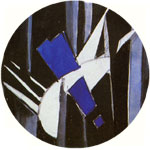
The mass of works attributed incorrectly to Alexandra Exter is not means limited to the series exhibited in Tours. In fact, seeing the many paintings that have been circulating over the past five years in various auction houses and private galleries, it would seem that the artist is at the core of an avalanche of fakes, the origin of which is hard to pinpoint. It is a sad state of affairs indeed that the number of works of dubious authenticity attributed to Alexandra Exter today largely exceeds the number of works whose authenticity is certain !
In recent years countless incorrectly attributed paintings have appeared at public auctions in France (mainly at the Hôtel Drouot and Versailles in Paris), England, and Germany (Munich, Berlin and Stuttgart as well as in French, Italian, Swiss and Spanish galleries. The Galerie Orlando in Zurich definitely takes the cake for continuing imperturbably to publish and exhibit works with the same characteristics (signatures, style of execution, subjects) as those features at the Tours exhibition, despite the injunctions of the Alexandra Exter Association [mfn]Lors d’une action de l’Association Alexandra Exter auprès de la justice Zurichoise cette galerie a bénéficié d’un blanc seing produit par un « expert » local qui confirme la « conformité » des œuvres mises en question en les comparant à d’autres contrefaçons ramassées de façon aléatoire sur internet. Il est évident que dans le cas d’une pareille « expertise » aussi bien les formes que les signatures sont semblables… car elles appartenaient à la même famille de contrefaçons. L’examen graphologique des signatures des œuvres zurichoises, pratiqué à Paris par les experts qui ont travaillé sur les signatures de l’exposition de Tours, a confirmé sans hésitation aucune que dans ce cas il s’agissait également de fausses signatures. Soucieuse de la probité de ses experts la justice suisse a ignoré la contestation de l’exposition de Tours de même qu’elle a ignoré les conclusions des experts français.[/mfn] Worse still, one of its recent catalogues makes an explicit reference to the Tours exhibition…
Some works of the same type have found their way into public collections : the Telefónica collection in Madrid
We welcome, on the other hand, the reaction of certain European museums that, in a demonstration of more serious professionalism, have already removed recent purchases of works wrongly attributed to Alexandra Exter from their exhibition rooms.
A series of works attributed to the Russian avant-garde, including four paintings attributed to Alexandra Exter
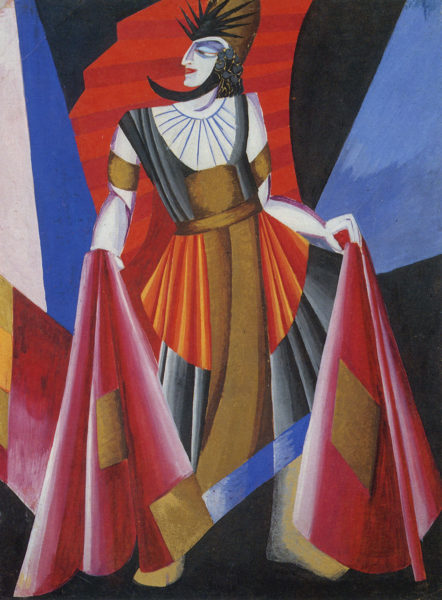
This is one of the artist’s most well-known works, since it was reproduced in colour as early as 1934 (in a book by A. Efros of the Kamernyj Teatr, Tairov’s chamber theatre). Unsigned, like nearly all of Exter’s gouache costume designs.
Bakrushin Theatre Museum, Moscow
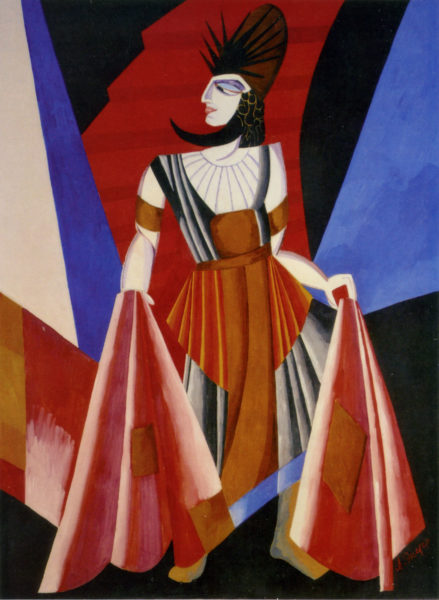
collection” (gouache signed on the bottom right). At least two other versions of this composition in oil on canvas, incorrectly attributed to Exter, are found in public collections (in Europe and Moscow). And it is likely that others are circulating on the art market.
To be continued…
